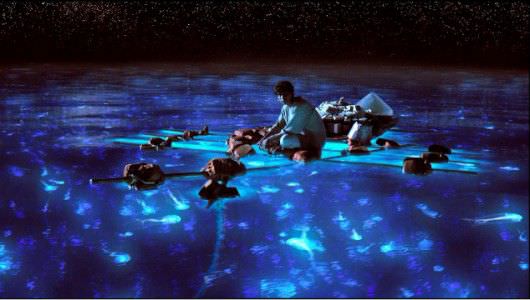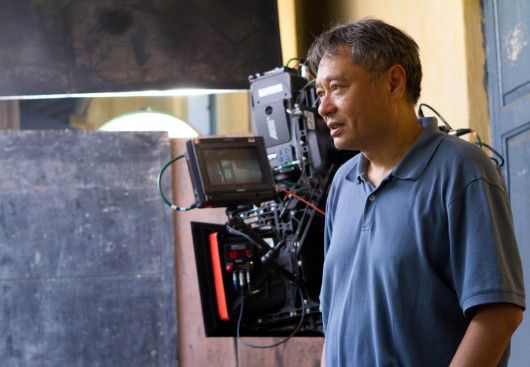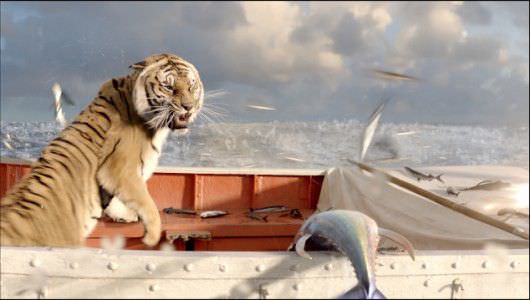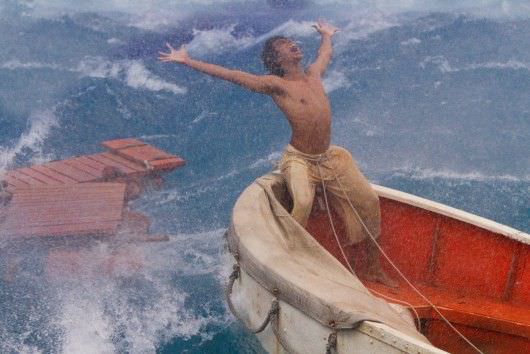Taming the Digital Tiger: An Interview with Oscar-Winning VFX Supervisor Bill Westenhofer About his Work on Life of Pi
The Credits spoke with to visual effects guru, Bill Westenhofer about his work on the acclaimed recent release, Life of Pi. Winner of the 2008 Academy Award for Achievement in Visual Effects for The Golden Compass (also nominated in 2006 for The Chronicles of Narnia: The Lion, the Witch and the Wardrobe), Westenhofer dished on what it was like working on Pi—from braving real storms at sea for reference points, to the artistry of director Ang Lee, and creating Richard Parker, that incredible Bengal tiger.
The Credits: How’d you became involved in Life of Pi?
Westenhofer: Ang Lee came to Rhythm & Hues (the visual effects and animation studio where Westenhofer works) in August of 2009 and he asked us whether a digital character would look more or less real in 3D. We thought that was a good question, so we took Aslan (the lion) from the first Narnia and he was actually pretty emphatic that we don’t touch a thing, just render it in stereo (3D) and see if it looks more or less real. So we did that and we all agreed that it improved your perception of it. It’s just one more cue that something’s really there. It was interesting because I found out several years later he really appreciated that we followed his instruction and didn’t try to sweeten the deal…in the four years [since the release of The Chronicles of Narnia: The Lion, the Witch and the Wardrobe] we could have rendered it better. In addition to the lion looking pretty good at the time, he liked the fact that we followed his instructions and that was one of the factors in giving us the job.

Where were the ocean scenes shot?
As soon as Ang made the decision to shoot this in 3D, that more or less wrote off any chance of shooting this on the real ocean. If there was any doubt left, in those research days we did go out in a lifeboat and a raft off Taiwan to see if the actor (Suraj Sharma, who played Pi when he’s lost at sea) could get comfortable. Just shooting video was so logistically and physically challenging we knew that those hundred pound [3D] stereo camera rigs were out of the question. And also because Ang wanted to make this an art film, he wanted the sort of control that we would have to put in the skies and the water. So that directed us toward the tank. We looked at the options of the existing tanks that were out there. There’s one in Louisiana, there’s one James Cameron built in Mexico for Titanic, but there were two features that were troubling Ang. One was it’s not often that you have a film where you spend so much time right up on the surface of the water. Three-fifths of the film was on the surface, so the water had to be really genuine. A second was that a lot of these tanks had what we call a “bathtub effect,” where they put in a wave machine and the tanks work because you get rebound off the walls and the waves keep building and create a choppy surface, but it doesn’t look like the open ocean, which has directionality to the waves.

Let’s talk a little about the relationship between a special effects supervisor and the director on a large film like this.
It was fantastic. What was unique about this project amongst other projects I have worked on was when we got back to Los Angeles and Ang was addressing the crew, he finished his whole opening spiel with, “I want to make art with you.” I think that was kind of the resonant theme. Since this was all shot in the tank in Taiwan [the tank was built from scratch in an abandoned airport] in front of a blue screen, we were given a pretty blank slate. It was really up to the digital effects crew to come up with the look and the artistry for the water part of the journey. Ang is very authentic so we did a ton of research with this, even going out on a coast guard cutter in the middle of the Pacific Ocean in a heavy storm and getting reference footage. We had real tigers on set so we spent eight weeks with real tigers, studying their mannerisms, which was great. Ang appreciates symbolism, so quite often the directions I would be given for skies were, instead of “go get me a sunset,” Ang would say, “give me a pensive sky,” or a “melancholy sky,” so it would be up to us to go through our library of skies and pick candidates I thought would fit his descriptions and we would go over those and set that for the scene.
So you had to integrate the actual waves in the tank with waves you created digitally?
Correct, and in stereo, which was the frightening thing. The thought of blending the real water with the stereo [water] was honestly the scary part. As the supervisor you have to act confident, but in the back of my mind I was wondering, how are we going to do this?
The technology has improved since Titanic, but it seems that water has always been particularly difficult to work on in special effects.
It is. In the computer you think you have more control, but to make it look real you have to let the simulation do its thing. It’s still ultimately as unpredictable as the real thing if you are trying to wrangle a shot. I give a lot of credit to the company that did the ship sinking sequence and the storm of God. They were doing massive simulations of storms with 20-foot waves in a storm surge and still Ang wanted the ability to art direct this and maintain artistic control. They really pulled that off, to run these huge simulations while giving him that freedom to adjust.
In terms of the crew, how many people were reporting to you throughout the production period?
There were about 1,300 people working on digital effects on this film.

Let’s talk about Richard Parker, that unbelievably realistic tiger.
Well, he wanted the tiger to be a realistic as possible, with no anthropomorphization. There was a team of about 15 people who were responsible for building the digital asset, and that took about a year to fine tune and get it to match. We probably spent six or seven months just building the basic shape and getting the fur, then once you have the shots that we’re cutting up, next to you have to make fine adjustments until it completely matches. That’s a year’s time since you start working on shots, lay it together and continue to make adjustments. There was a lot of evolutionary stuff from what we’ve done with animals in the past and there were some technical achievements in terms of the lighting of the hair, in particular the way light comes in and bounces around in the soft white fur. There is something called sub-surface scattering and it’s difficult to render that. We spent a ton of time scrutinizing all the reference footage of the live tigers that we took. We had about a hundred hours of footage that we took of the tigers when they were in Taiwan and it was getting down to the tiny nuances of the claws and toes that the animators put in. We would review a shot with Ang and he would approve the animation and then when he locked the specific actions off, we would go and spend two weeks doing the tiny stuff.
Was Ang shooting live action concurrently while you were working on reaction shots or reverse shots with the tiger, or did the tiger come first and then he built around what you had discussed?
We spent a year pre-vising the movie. We had the team sit down with crude animation and simple renders and he basically set up the film from the moment the ship sinks until they arrive on the beach, and we pretty much shot what we pre-vised. The pre-vis can be a tool and it’s up to the director how much they utilize it. He really spent a lot of time analyzing the shots so that when we got to set, we could show everybody this is what the set’s going to be, we could talk to the actor, Suraj, and say, “this is where the tiger’s going to be,” and everyone could see what was going to happen, which took care of a lot of the confusion that would have otherwise resulted. I also want to point out that Suraj was absolutely fantastic. I’ve worked with seasoned actors, and when you try to say, “there’s an invisible character here,” they have a hard time grasping it. He was trying to balance on a boat that was rocking back and forth, and you could even just say, “the tiger’s walking from here to here,” and you could see in his eyes that he was picturing it and selling his invisible co-star.
So you didn’t use a mock-up or a person pretending to be the tiger?
We did both. We did anything we could to help him. Some shots were simple and you could just say it, but if it helped to have him to have someone in a blue suit for the tiger, my animation director would do it. He earned his chops one day during the flying fish sequence, he was grabbing hold of a pole that Pi is reacting with and the bottom of the boat was filled with dead fish that we bought from the supermarket. He was in a blue leotard, sitting in rotten fish, pretending to be the tiger. He earned his credit that day.

Do you have a favorite scene or shot in the movie that you are particularly proud of?
I love the whale sequence; the jellyfish in there are really cool. But, I think my favorite scene is the flying fish sequence with the tiger. It just looks really stunning. There were times where we had to just completely replace the lifeboat because it made sense. I don’t think anyone’s ever going to notice that but some of those shots are completely digital and I think we pulled it off. What was cool about this was, we had done digital animals before, trying to make them as real as possible and then they’d have to get up and sing or dance or do something obviously fake. I told the crew, here’s your shot. This is a tiger, it’s going be a tiger. If you’re ever going to fool your colleagues, this is your chance. And I think they rose to the occasion.
Featured Image: Pi Patel (Suraj Sharma) and a fierce Bengal tiger named Richard Parker must rely on each other to survive an epic journey. Photo courtesy Rhythm & Hues, Twentieth Century Fox Film Corporation
Other interviews:
Meet Scoot McNairy, one of the brightest up-and-coming young actors in Hollywood.
Check out our interview with The Sessions director Michael Lewin, and find out the incredible story behind this film.
How do you swap Gerard Butler's face with a professional surfer's so you can film a movie like Chasing Mavericks and have the surfing scenes impress everyone, even the professional surfers themselves? We found out when we spoke to Scott Anderson, Visual Effects Supervisor extraordinaire.



